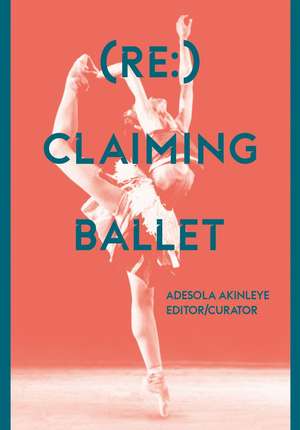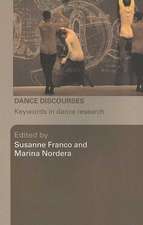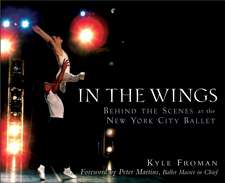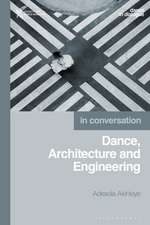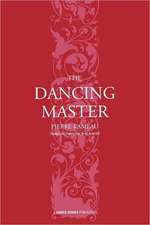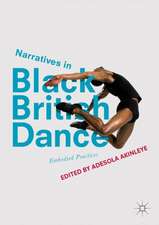(Re:) Claiming Ballet
Editat de Adesola Akinleyeen Limba Engleză Paperback – 25 mai 2021
With contributions from professional ballet dancers and teachers, choreographers, and dance scholars in Europe and the United States, the volume introduces important new thinkers and perspectives. An essential resource for the field of ballet studies and a major contribution to dance scholarship more broadly, (Re:) Claiming Ballet will appeal to academics, researchers, and scholars; dance professionals and practitioners; and anyone interested in the intersection of race, class, gender, and dance.
Preț: 296.06 lei
Nou
Puncte Express: 444
Preț estimativ în valută:
56.65€ • 59.15$ • 46.78£
56.65€ • 59.15$ • 46.78£
Carte disponibilă
Livrare economică 26 martie-09 aprilie
Livrare express 11-15 martie pentru 45.10 lei
Preluare comenzi: 021 569.72.76
Specificații
ISBN-13: 9781789383614
ISBN-10: 1789383617
Pagini: 328
Dimensiuni: 170 x 244 x 23 mm
Greutate: 0.68 kg
Editura: Intellect Ltd
Colecția Intellect Ltd
ISBN-10: 1789383617
Pagini: 328
Dimensiuni: 170 x 244 x 23 mm
Greutate: 0.68 kg
Editura: Intellect Ltd
Colecția Intellect Ltd
Notă biografică
Adesola Akinleye is a choreographer, artist, scholar, and senior lecturer at Middlesex University in London. She creates dance works to voice lived experiences through creative moving portraiture. Her work has received numerous accolades, including the Bonnie Bird New Choreography Award and the Association of Dance of the African Diaspora’s Champion Trailblazer Award.
Cuprins
Introduction: Regarding claiming ballet / reclaiming ballet
Part One – Histories
Chapter 1: Ballet, from property to Art – Adesola Akinleye
Chapter 2: Should there be a Female ballet canon? Seven Radical Acts of Inclusion - Julia Gleich and Molly Faulkner
Chapter 3: Arabesque en Noir: The Persistent Presence of Black Dancers in the American Ballet World - Joselli Audain Deans
Chapter 4: Portrayals of Black people from the African Diaspora in western narrative ballets – Sandie Bourne
Part Two – Knowledges
Chapter 5: The traces of my ballet body - Mary Savva
Chapter 6: Ballet Beyond Boundaries – Personal History. Brenda Dixson Gottschild
Chapter 7:“Auftanzen statt Aufgeben” and The Anti Fascist Ballet School -Elizabeth Ward
Chapter 8: Dancing Across Historically Racist Borders – Kehinde Ishangi
Part Three – Resiliences
Chapter 9: Dance Theatre of Harlem’s radicalization of ballet in 1970s & 1980s – Theresa Ruth Howard
Chapter 10: Personal testimony as social resilience - Theara J. Ward
Chapter 11: “Can you feel it?”: Pioneering Pedagogies that Challenge Ballet’s Authoritarian Traditions - Jessica Zeller
Chapter 12: The Ever After of Ballet – Selby Wynn Schwartz
Chapter 13: Ballethnic Dance Company Builds Community: Urban Nutcracker leads the way – Nena Gilreath
Part four – Consciousnesses
Chapter 14: The Counterpoint Project – When Life Doesn’t Imitate Art - Endalyn Taylor
Chapter 15: Ballet’s Binary Genders in a Rainbow-Spectrum World:
A call for progressive pedagogies - Melonie B. Murray
Chapter 16: Dancing through Black British ballet: Conversations with dancers - Adesola Akinleye and Tia-Monique Uzor
Chapter 17: Ballet Aesthetics of Trauma, Development, and Functionality – Luc Vanier & Elizabeth Johnson
About the contributors
Index
Part One – Histories
Chapter 1: Ballet, from property to Art – Adesola Akinleye
Chapter 2: Should there be a Female ballet canon? Seven Radical Acts of Inclusion - Julia Gleich and Molly Faulkner
Chapter 3: Arabesque en Noir: The Persistent Presence of Black Dancers in the American Ballet World - Joselli Audain Deans
Chapter 4: Portrayals of Black people from the African Diaspora in western narrative ballets – Sandie Bourne
Part Two – Knowledges
Chapter 5: The traces of my ballet body - Mary Savva
Chapter 6: Ballet Beyond Boundaries – Personal History. Brenda Dixson Gottschild
Chapter 7:“Auftanzen statt Aufgeben” and The Anti Fascist Ballet School -Elizabeth Ward
Chapter 8: Dancing Across Historically Racist Borders – Kehinde Ishangi
Part Three – Resiliences
Chapter 9: Dance Theatre of Harlem’s radicalization of ballet in 1970s & 1980s – Theresa Ruth Howard
Chapter 10: Personal testimony as social resilience - Theara J. Ward
Chapter 11: “Can you feel it?”: Pioneering Pedagogies that Challenge Ballet’s Authoritarian Traditions - Jessica Zeller
Chapter 12: The Ever After of Ballet – Selby Wynn Schwartz
Chapter 13: Ballethnic Dance Company Builds Community: Urban Nutcracker leads the way – Nena Gilreath
Part four – Consciousnesses
Chapter 14: The Counterpoint Project – When Life Doesn’t Imitate Art - Endalyn Taylor
Chapter 15: Ballet’s Binary Genders in a Rainbow-Spectrum World:
A call for progressive pedagogies - Melonie B. Murray
Chapter 16: Dancing through Black British ballet: Conversations with dancers - Adesola Akinleye and Tia-Monique Uzor
Chapter 17: Ballet Aesthetics of Trauma, Development, and Functionality – Luc Vanier & Elizabeth Johnson
About the contributors
Index
Recenzii
"[This book] examine[s] the white, cis, heteropatriarchal history of ballet, and how many dancers and choreographers are grappling with this history. It has started some very important conversations about the role of ballet today and how this art can thrive within the beauty of difference."
"This anthology is a valuable tool for engaging new audiences in ballet; it is a call-to-action for younger generations to connect ballet with their lived worlds. It will be of interest to academics, researchers, or students working in the fields of dance, theater, performing arts, and cultural studies—especially within the intersection of gender, race, and dance. I recommend this book to anyone who wants to acquire a broader knowledge of ballet as a global art form with the potential to become a key representation of our multicultural society."
"(Re:) Claiming Ballet is a comprehensive guide to the extensive influence of the marginalized on ballet. For readers who interact with other performing arts sectors, such as music or theater, it would be beneficial to carefully consider the similarities between how issues of class, gender, and race permeate both the ballet world and other facets of the performing arts."
